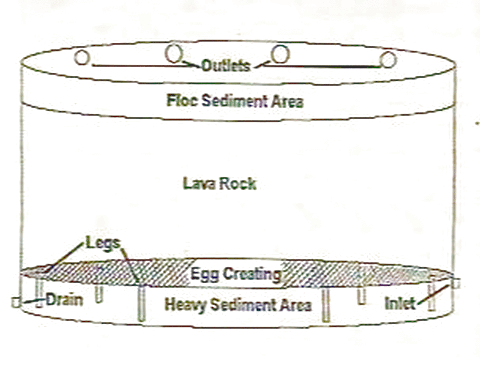| HOME | PLANTS | FISH | TIPS | LINKS | FEEDING |

|
|
||||
| PEA GRAVEL | LARGER GRAVEL | LAVA ROCK | SAND | DIATOMACEOUS EARTH |
|
|
|||
| BIO-BALLS | OPEN CELLED FOAM RUBBER | STRAINERS | |
| FILTER MATS | SPIRALFLO | SIPORAX | BRUSHES | |||
CONSTRUCTING OUR FILTER |
The key to a properly designed biological filter is the media bed, which provides a place for the bacteria to live and grow. This type of filter requires a continuously operating pump in order to keep the good bacteria alive, which without water, can die within six hours.
There are as many different types of material that can be used as there are people using them. Below, you will find a list of the choices that we are familiar with. Each of these have their pros and cons, as we have learned through experience. A filter just isn't a filter if it doesn't have the right filter material. Fancy space-age bio-balls, lava rock, foam rubber, even old hair rollers have been tried and tested in the quest for clean water.
Filter material does two things. It removes particals from the water (machanical filtration), including fish waste, algae, dirt, and other debris. It also plays a role in removing harmful chemicals such as ammonia and nitrites from the water (biological filtration) by providing a surface for bacteria to live and grow. Filter material may work well for machanical and biological filtration, or it may only be suitable for one kind, but not the other. It's important to know what you want your filter to do for you.
It's also important to remember that all kinds of materials have their limitations. One is that water follows the path of least resistance. In other words, water will always try to go around the filter material rather than through it. Your filter media has to fit into the chamber, so that the water doesn't compleatly bypass it. Do not leave large gaps between the filter material and the sides of the chamber. Placing loose media in nylon bags may make it easier to remove for cleaning, however we don't recommend this because it makes it almost impossible to get a good fit around the edges.
Another limitation to all filter material is the effect of channeling. This occurs when sediment falls out of the water and attaches to the filter material, creating ruts and grooves that restrict and direct the flow of water. Bacteria usually will not survive where sediment build-up has occurred on the filter medium. Some kinds of filter material are more prone to channeling than are others.
Ideally, pond water should flow evenly over and through the filter medium. Even distribution makes machanical and biological filtration much more efficient. Particles are removed more completely. Bacteria has a better chance to colonize more of the filter medium.
Many filtering systems use two or more kinds of materials. For example, filter mats are used for mechanical filtration and lava rock for biological filtration. This makes it more convenient to maintain the filter and easier to position the filter in the overall pond scheme.
Filter materials fall into two general categories -
natural and synthetic. Both serve useful purposes in
filtering pond water so that it is clean and clear.

| HOME | PLANTS | FISH | TIPS | FILTER | LINKS | FEEDING |